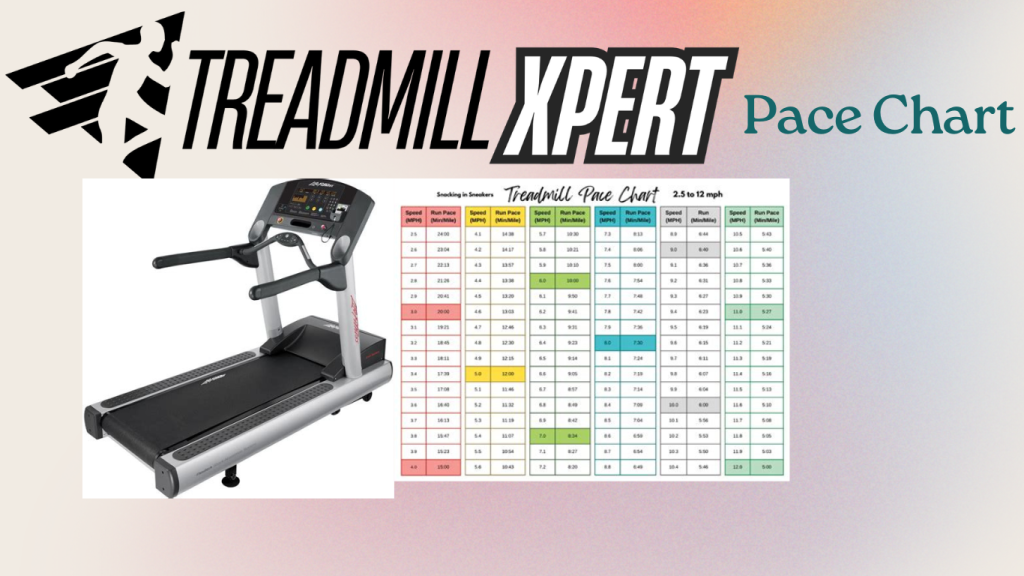What is a treadmill pace chart?
A treadmill pace chart is a tool and make the easy that helps runners and walkers convert their speed on a treadmill to an equivalent outdoor pace or vice versa. It typically shows the relationship between Miles per hour (mph), Minutes per mile (pace), Kilometers per hour (km/h), and Minutes per kilometer (pace).
Do you know why a pace chart is useful?
This chart is helpful because treadmills often display speed in mph or km/h) Switching between indoor and outdoor running helps runners maintain consistent training paces. This chart is handy because it allows for easy conversion between different units of speed and pace.
A basic treadmill pace chart looks like this in MPH, Min/Mile, KM/H, Min/KM.
MPH Min/Mile KM/H Min/KM
5.0 12:08. 7:30
6.0 10:0 9.7 6:12
7.0 8:30 11.3 5:19
8.0 7:30 12.00 4:39
9. 6 6:4 14.00 4:08
What are the benefits of a treadmill pace chart?
Pace charts offer several benefits across various applications. Here’s an overview of some key advantages:
- performance tracking
- Goal setting
- Time management
- Consistency
- Early problem detection
- Motivation
- Resource allocation
- Predictive analysis
- Communication tools
- Optimization.
- Performance tracking: Pace charts allow individuals or teams to monitor progress against planned or expected performance of the workout or other activities.
- Goal setting: They help establish realistic targets and milestones for individual or group goal-setting.
- Time management: Pace charts assist in allocating time efficiently for tasks or activities, allowing you to manage time effectively for each task.
- Consistency: They promote a steady, sustainable pace instrumental in long-distance running or project management activities.
- Early problem detection: Deviations from the expected pace can quickly highlight issues or bottlenecks and easily detect problems in each activity.
- Motivation: When on track or ahead of pace, a Visual representation of progress can be motivating, especially
- Resource allocation: In project management, pace charts can help distribute resources more effectively and provide accessible and practical resources.
- Predictive analysis: Pace charts can help predict future outcomes or completion times by analyzing past performance. They are a comparison chart of performance.
- Communication tool: They provide a clear, visual way to communicate progress to stakeholders or team members, help identify problems, and discuss issues when we face them during activities.
- Optimization: Over time, pace charts can be used to optimize strategies, improve overall performance, and compare our performance.

What pace chart can help you maintain the right intensity during a treadmill workout and achieve your training goals?
Sing a pace chart C Here’s how to effectively use a pace chart during your treadmill session
- Set your workout goals
- Convert pace to speed
- warm up
- Adjust treadmill settings
- Monitor and adjust
- Adjust speed
- Interval training
- Track progress
- Cool down
- Account for incline
- Set your workout goals: what you want to achieve (e.g., easy run, tempo run, interval training) and the corresponding pace ranges, which are determined essentially.
- Convert pace to speed: Use the chart to convert your target pace (minutes per mile or km) to mph or km/h, typically displayed on treadmills during the workout.
- Warm-up: start slowly for 5-10 minutes to warm up your muscles and start running.
Adjusted treadmill settings: Set the treadmill to the speed of your target pace, and the pace chart will help. - Monitor and adjust: You should regularly check if you’re maintaining the desired effort level and should monitor it.
Adjust speed up or down as needed, using the chart for reference. - Interval training: Interval training is helpful for strenuous workouts. Use the chart to quickly switch between different paces (e.g., from easy to strenuous efforts) for interval workouts.
- Track progress: Note the speeds/paces you used to gauge improvement over time. And get progress spontaneously.
- Cool-down: Gradually reduce speed in your workout’s last 5-10 minutes. The pace chart helps. Account for incline, so you may need to reduce speed to maintain the same perceived effort. Adding an incline increases effort.
- Use for different workouts: Refer to the chart for various training types (long runs, Tempo runs, intervals) to ensure you’re hitting the proper paces and help users with the best workout.
- Using a pace chart for running: particularly outdoors, can help you maintain consistent effort and achieve your training goals.
Here’s how to effectively use a pace chart in running
- Determine your goal pace
- Memorize key paces
- Use for different training zones
- Pace yourself during races
- GPS watch setup
- Convert between units,
- Determine your goal pace: Decide your target based on your training plan or race goals to help the pace chart.
- Memorize key paces that are relevant to your training. Estimate finish times and pace groups. Familiarize yourself with a few key pace/speed equivalents. Use for different training zones like easy runs, Tempo runs, interval training, and race pace
- Pace yourself during races: Use the chart to plan your race strategy and maintain the proper pace.
In outdoor running
- GPS watch setup: Program your watch with pace alerts based on the chart data due to this GPS watch setup.
- Adjust for terrain: Remember that hills and different surfaces may affect your pace, so you can adjust for terrain.
- Track progress: You can compare your paces to the chart to gauge improvement over time.
- Convert between units: It’s beneficial when discussing paces with runners who use different units (mph vs. km/h).
- Estimate finish times: Use the chart to project race finish times based on your current pace.
- Pace groups: In races, use the chart to choose the right pace group to join in outdoor running.
- A slider to adjust speeds and see the corresponding pace in real-time in the pace chart.
- The paid cart also presents A reference table showing typical treadmill speeds and their equivalent paces.
This can help plan workouts at a specific pace, understand the relationship between treadmill speed and running pace, and quickly convert between miles per hour and minutes per mile.
The calculator covers speeds from 4 mph (a brisk walk) to 12 mph (a fast run) and can be measured through a pace chart.
